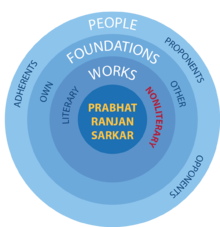Microvita
| Microvita | |
|---|---|
| Short description | Fundamental building blocks of life |
| Location in Sarkarverse | |
Microvita is a theory that was introduced by Prabhat Ranjan Sarkar on 1986 December 31 and amplified in numerous subsequent discourses and demonstrations.[nb 1] The discourses given up to 1989 were compiled in the book Microvitum in a Nutshell.
Definition and introduction
The term "Microvita" is plural for "Micro-vitum" and literally means "micro-life". According to this intuitional theory microvita are entities which come within the realms both of physicality and of psychic expression. They are smaller and subtler than physical atoms and subatomic particles, and in the psychic realm they may be subtler than mind–stuff, and contribute to "pure consciousness".[1] The author predicts that they will soon be recognized by conventional science.[2]
According to the Dutch microvita researcher Henk de Weijer "microvita are tiny little creative catalysing agents. They build atoms of matter, biology and mind, while cooperating with the characteristics of subatomic particles and pure energy".[3]
Starting from the basic concept expressed by Sarkar in his discourses,[2] the scholar Richard Gautier (aka Ratnesh) highlighted the key involvement of microvita in the structural organization of energy for the creation and maintenance of structures. He wrote: "...without microvita, no physical structure can exist. This because without microvita, energy or prana cannot be organized to become vital energy and create or maintain the existence of a structure."[4]
Notes
- ^ Between 1955 and 1990 the author wrote in English, Bengali and Hindi. He wrote in the name "Shrii Prabhat Ranjan Sarkar" when treating sociology, economics, philology and various other subjects, and in the name "Shrii Shrii Ánandamúrti" when focusing on spiritual topics. Many of his books he gave as dictations; others were compiled from his discourses, some of them in small pocket-books.
References
- ^ Dalal 2011, p. 325.
- ^ a b Sarkar 1991 third ed..
- ^ de Weijer Nov. 2009.
- ^ Ratnesh (Richard Gautier) 1988, p. 59.
Sources
- Dalal, Roshen (23 November 2011) The Religions of India: A Concise Guide to Nine Major Faiths Penguin Books India ISBN 978-0-14-341517-6
- Ratnesh (Richard Gautier) (1988) Microvita cosmic seed of life Mainz: Ananda Marga Pracaraka Samgha ISBN 3-921769-22-1
- Sarkar, Prabhat Rainjan (Ac. Krsnatmananda Avt. Editor) (1991 third ed.) Microvitum in a Nutshell Kolkata: Ananda Marga Publications OCLC 56905884
- de Weijer, Henk (Nov. 2009) "Plexuses and Microvita" Gurukul Network 33 retrieved 2013-2-1
Further reading
- Van den Bovenkamp, Frank "Microvita and cosmology. Philosophical, physics and future science implications of P.R. Sarkar’s new creational paradigm"
